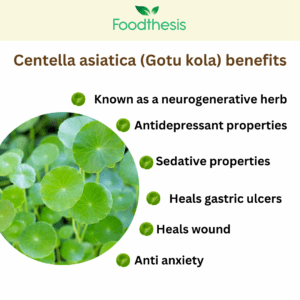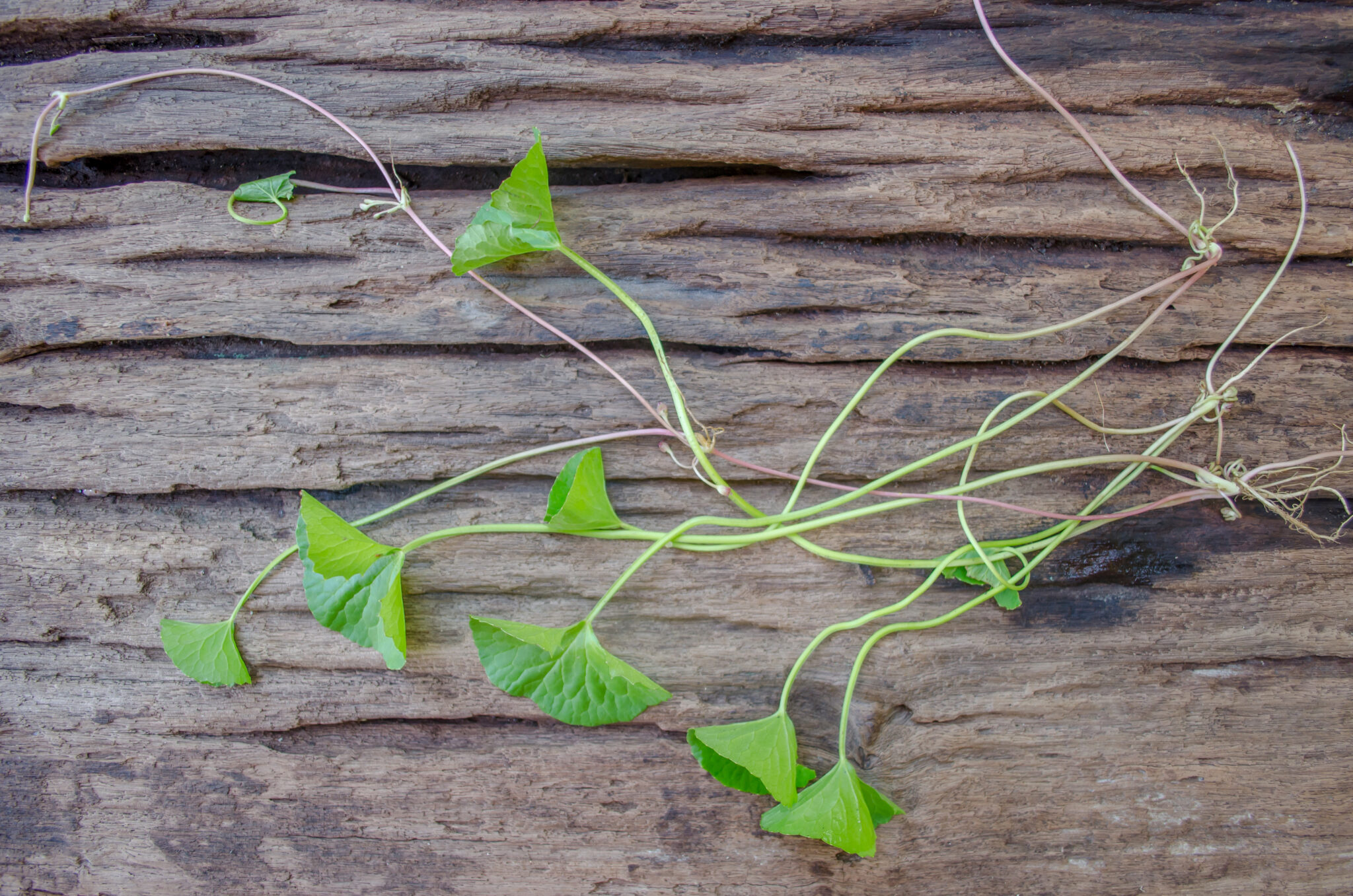Introduction
Botanical description
The plant Centella asiatica (Gotu kola)is a perennial herbaceous creeper that grows mainly in moist places. Leaves are edible yellowish-green in color. The petioles of the leaves are thin and long.
Name
Asiatic pennywort
Scientific name
Centella asiatica (L.) Urban (Syn. Centella coriacea Nannfd., Hydrocotyle asiatica L., Hydrocotyle lunataLam., and Trisanthus cochinchinensis Lour.)
Family
Apiaceae
Common names
Gotu kola, Asiatic pennywort, Indian pennywort, Indian water navelwort, Jalbrahmi, wild violet, and tiger herb” in English.
Distribution
China, South East Asia, India, Srilanka, and Africa.
Medicinal properties
The main key feature of this plant is its ability to heal wounds and enhance memory. WHO also recommends this plant for memory enhancement (1). Other important biological activities are anti-inflammatory, antipsoriatic, antiulcer, hepatoprotective, anticonvulsant, sedative, immunostimulant, cardioprotective, antidiabetic, cytotoxic, antitumor, antiviral, antibacterial, insecticidal, antifungal, antioxidant, and for lepra, and venous deficiency treatments (2).
Important compounds present in Centella asiatica
Asiatic acid, madecassic acid, asiaticoside, madecassoside, and madasiatic acid, betulinic acid, thankunic acid, and isothankunic acid (3,4). Triterpenes brahmic acid, centellin, centellicin, asiaticin, bayogenin, terminolic acid, centellasapogenol A, centella saponins A-D, ursolic acid, pomolic acid.
Flavonoid like quercetin, kaempferol, patuletin, rutin, apigenin, castilliferol, castillicetin, and myricetin (5,6,7).
Polysaccharides, polyacetylenes, sterols, and phenolic acids are also present in the plant.
Health benefits of Centella asiatica (Gotu kola)

1. Heals wound
The plant has been used traditionally in many civilizations for wound healing. The main component asiaticoside helps in increasing collagen formation and angiogenesis thus healing wounds rapidly. These compounds also inhibit inflammation and improve capillary permeability (8)
2. Sedative properties of Centella asiatica
The plant Centella Asiatica possesses a central nervous system effect. It has tranquilizing, rejuvenating, and sedative properties along with memory-enhancing capacity due to the compounds brahmoside and brahminoside (8).
3. May relief from anxiety
Centella asiatica also has anxiolytic properties. The components madecassoside and asiaticoside possess anxiolytic activity. These compounds help in the treatment of both acute and chronic anxiety in the pathological state (9).
4. Possible antidepressant properties of Centella asiatica
The triterpenes present in the plant Centella asiatica (Gotu kola) pose antidepressant effects. Studies done on the animal model suggested that the triterpene helps in creating a momentous diminution in corticosterone levels and a notable increase in the amount of monoamine-related neurotransmitters (10).
5. Centella asiatica may be helpful in the treatment of epilepsy
The extracts of Centella asiatica help in the treatment of epileptic seizures. This is mainly because of the anticonvulsant and neuroprotective activity of the plant. Triterpenoid glycosidic compounds of Centella asiatica help in increasing the cerebral level of GABA thus used in the treatment of epilepsy because of its anxiolytic and anticonvulsant properties (11).
6. May treat gastric ulcers
Centella asiatica extracts help in the inhibition of gastric ulcers. The plants help in protecting and strengthening the mucosal barrier of the gastric tract thus protects from oxidative damage. The anti-ulcerogenic activity of fresh juice of Centella asiatica is mainly because it increases the GABA level of the brain. The healing efficiency and anti-inflammatory efficiency of the extract also help in protecting against ulcers (12).
7. Possible antidiabetic property of Centella asiatica
Its extracts help in reducing the blood glucose level. Studies done on the animal body show that the extract of this juice lowers the blood glucose absorption by increasing the fibrosis of islets in diabetes which also plays a vital role in the prevention of islet dysfunction (13).
8. Protects from neurodegenerative diseases
The plant Centella asiatica helps in enhancing the cognitive effects. These compounds help in repairing and restoration of damaged neurons and improve nerve impulse transmission. The main compound of Centella asiatica that repairs the brain cells is triterpene saponosides (14). Therefore the extracts of this plant help in the protection of neurological-related disorders and enhance memory.
9. Possible radioprotection property of Centella asiatica
Studies suggested that 100mg/Kg of body weight increases survival time and prevents the harmful effects of radiation on the body (15).
10. Centella asiatica may helps in the regeneration of nervous tissue
Asiatic acid present in the leaves of Centella asiatica helps in the regeneration and enhancement of nervous tissue as per studies done on human neuroblastoma cells (16). Therefore, enhances the learning memory.
11. Possibly prevents Alzheimer’s disease
Alzheimer’s disease is a dementing neurodegenerative disease of old age. Oral administration of Centella asiatica extracts helps in the prevention or slowing down of these diseases. The plant mainly involves reducing oxidative stress, and prevents beta-amyloid plaque formation, dopamine neurotoxicity, and enzyme inhibition (17).
12. May delay Parkinson’s disease
It is also a neurodegenerative disorder associated with the degeneration of dopaminergic neurons. Studies done on animal models show a marked decrease in the degeneration of neurons due to asiaticoside dose of Centella asiatica. It protects dopaminergic neurons by opposing MPTP (1- Methyl-4-phenyl-1,2,3,6-tetrahydropyridine) and improves locomotor dysfunction (18).
Side effects of Centella asiatica
1. Take the recommended dose
Although the herbal extracts are safe to use, and Centella asiatica is full of medicinal properties and health benefits therefore also has a great demand in the market but still before taking should consider the recommended dose.
2. Skin irritation
Few cases of skin irritation and contact dermatitis were reported on taking Centella asiatica
3. Infertility in females
Studies suggested that regular consumption of Centella asiatica causes infertility in females (19). Breastfeeding mothers should also avoid taking Centella asiatica.
Dosage
600 mg of dried leaves of Centella asiatica is widely recommended. The standardized CA extract containing up to 100% total saponins (triterpenoids), 60 mg once or twice per day, is frequently used in modern herbal medicine (19).
Centella asiatica tea
This is one of the good ways to consume the leaf extracts of Gotu kola. 1 to 2 teaspoons (5-10 g) of dried leaf with hot water and honey and a steeping time of 10-15 min is suggested.

Can you grow this in the United States?
Yes you can definitely grow this herb in US all u need is shade and moist soil…